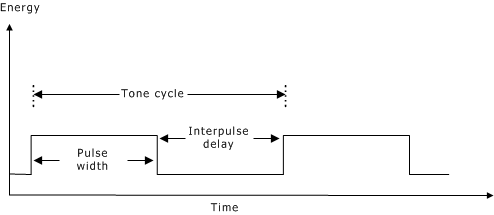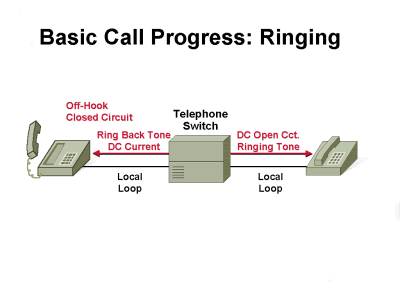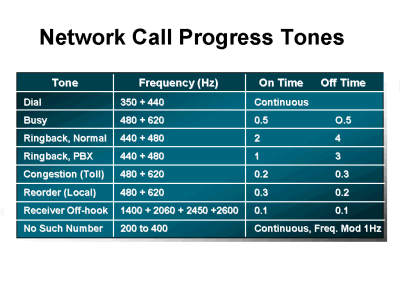Call-progress tone
Call progress tones are beeps that can be heard in the telephone receiver or speaker of a terminal. In overclocking, sound sequences, and / or pitch different audible tones participants represent the current state of a phone line at telephone networks ( telephone network, mobile network) and telephone systems.
Keys
- The dial tone ( outdated dial tone, dial tone, dial tone office, in English: dial tone ) signaled to the caller the willingness of the switching device ( switch, PBX ) to accept the dialing information ( phone number).
- The special dial informs the subscribers of particular states or properties of the telephone connection, such as via an activated call diversion or a received message from a caller.
- The ringing tone ( also sometimes incorrectly dial tone, English: ring -back tone ) signaled to the caller that the line to the called party is free and the subscriber is called. Under the name ringback offer network operators for several years at an additional cost with a service that can be inferior to their callers with the ring tone music with the connection owner; It is here just around the counterpart to the ringtones.
- The call waiting tone signals a phoning participants that another call arrives at him and waits.
- A busy tone ( Busy participants ) indicates to the caller that the called party is busy or there has rejected the call.
- The Gassenbesetztton differs from participants busy by a faster sequence of notes (subscriber busy: about one tone per second, streets busy: about three tones per second, the sounds are just as long as the breaks, each about 1/6 second). If problems occur while connecting to the called party unavailability in switching equipment, the caller receives busy tone at this special many network operators. The term busy streets means that a certain number range is unavailable due to an overload or fault, eg all numbers of the local network, starting with 50xxxx. One gets the Gassenbesetztton usually be heard even before you have chosen the full number to the end. Alternatively, the announcement participant is temporarily not reachable recorded, or sounds when calls from mobiles a short sequence of three tones as a sign of network congestion.
- The Haltton is sent on hold a call and signaled the provisional speech interruption to the other party, who has just this on hold. This allows, for example, the other party to establish a further connection to a third interlocutor in order to obtain a query during an active call.
- The cut-in or an alert tone (short- on-tone ) signals to all participants involved, that someone of the existing connection has been switched on and is listening. At the time of manual switching the sign is used when the remote office pointed to an existing local call in on an important long distance call.
- Acknowledgment tones are sent to participants in the programming of connection and phone settings, as well as in the activation of features by telephone.
- Warning tones are sent in exceptional situations, indicating a blockade of a device or point to a particularly high fee for a call. An example of the blockade of a device is the Howlertone, which is intended to alert even at a greater distance audible on a off-hook handset. However, the Howlertone is not used because of its potential danger to the human ear in ear earphone held in Europe, but is widely used in Asia and America.
- Sonderinformationston (SIT ) indicates that the calling party that special circumstances make it impossible to connect. The best known is probably the tone sequence of three short tones rising in choosing an unused number, possibly supplemented by the message " No connection under this number".
Another sound that is not like the others but is heard in the handset, the ringer or ringtone. (English: ring tone ). When ringing, the ringing of the phone is called the called party in general. If analogue telephones of an incoming call is signaled by the ringing voltage, traditionally at the same time provides the energy to generate the ringing tone ( ringing ). For ISDN devices and mobile but the signaling is separate from the production of the ringing tone.
Call progress tones ( Germany )
With the announcement: 330-330 - 330-1600
Further progress tones ( Germany )
The exact specification of call progress tones used in the field of Deutsche Telekom can be found in the technical description of the analog selection terminals on T-Net/ISDN T-Com ( 1TR110 -1).
Tone
For electromechanical switches the call progress tones were generated with call and signal machines, which are also electromechanical components. This analog switching equipment was gradually replaced by digital systems, in which the audio signals are generated electronically.
Historical progress tones ( Germany )
By the end of 1998, the EMD switching centers were mainly in the Federal Republic of Germany in action. Their reputation and signal machines produced characteristic and well audible tones.
The root of this call progress tones consisted of two superimposed sine waves with a frequency of about 440-480 Hz, which was clocked according to the respective importance.
The following table contains the sounds that could be heard up to the time of technical change in the 1990s.
The dial tone, however, was amended in the Federal Republic in September 1979, The interrupted dial tone, the Morse code for the letter "A", was replaced by the non-synchronized root. In the GDR, however, the Morse -A could still be heard until the reunion.




/Year_5/ELC-523-Advanced%252520Communication%252520Systems/Switching/Signalling/Images/Call_in_Progress_Tone.GIF)





